|
I read an article, a review, of a show of new
paintings at MOMA, in which the writer was lamenting that there
was nowhere new to go, aside from outlandish gimmicks, and therefore
painting was finished. It could bleed, he said, but not heal.
That was Peter Schjeldahl. But this is a misunderstanding of
creativity and not what Arthur Danto meant by "The End of
Art." It's true that this is the feeling that dominated
Modernism, whose main tendency was to eliminate everything considered
to be necessary to a work of art up until that moment - narrative,
verisimilitude, line, color, whatever - in search of the final
essence. It was a spiritual quest, really, in spite of some of
its phenomenological results, like action painting and minimalism.
But it was like the search for the Wizard of Oz, and it ended
- for me - in the '70s when Sol LeWitt eliminated the art object
itself. The final work was the concept, which in this case was
a list of instructions on how to make the painting or the "structure,"
as he called his sculptures. With the physical presence gone,
or unnecessary, there was nothing left to eliminate, no Wizard
behind the curtain. At least that's the way I saw it, and it
ended my futile pursuit of uniqueness. Or gave me an excuse to
end it.
Arthur Danto called it "The End of Art," and the three
of us are a good example. He meant the end of the linear history
of Western art theory: the progression from Romanticism to Realism
to Impressionism to Expressionism to Cubism to Abstraction to
Minimalism to Conceptualism. The end. After that there are no
more isms, no more manifestos, no more movements. We were
forced in upon ourselves, to find our own truths, our own personal
way to express them. It was only when I gave up my pursuit of
uniqueness and started trying to paint like the Old Masters that
people started saying my work was unique. Danto quotes Leonardo
da Vinci, ogni dipintore dipinge se ("every painter
paints himself").
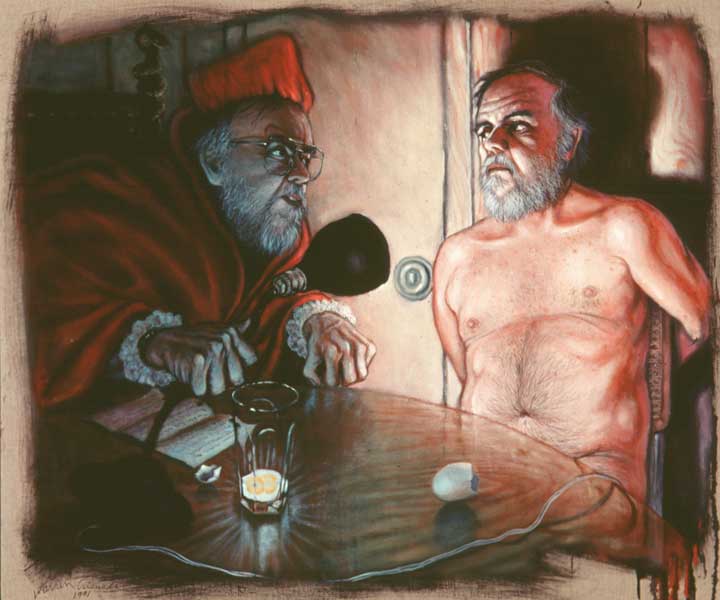
Warren Criswell, The Question, 1991, oil on linen, 36 x 43 inches (private collection) |
Sammy stayed with AbEx but let it evolve into
something difficult to categorize. Just as in a great symphony
you discover something new every time you hear it, every time
you look at a painting of Sammy's you see it differently.
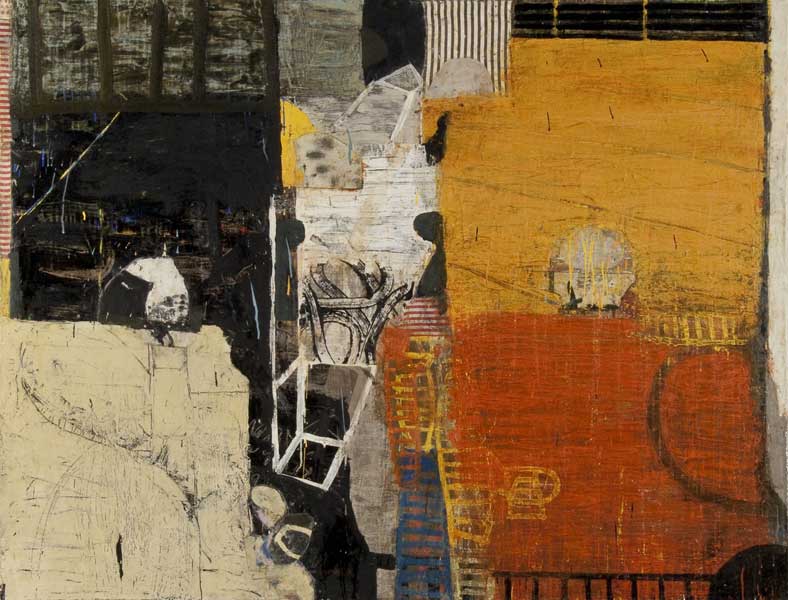
Sammy Peters, Impulse: significant; origin,
2015, mixed media on canvas, 52 x
68 inches (Remember that worm....) |
In the '80s, David, who had gone into theater
in response to the announced death of painting, now drifted back
into the graveyard of visual art, translating his scripts into
stark charcoal dramas on paper.
|
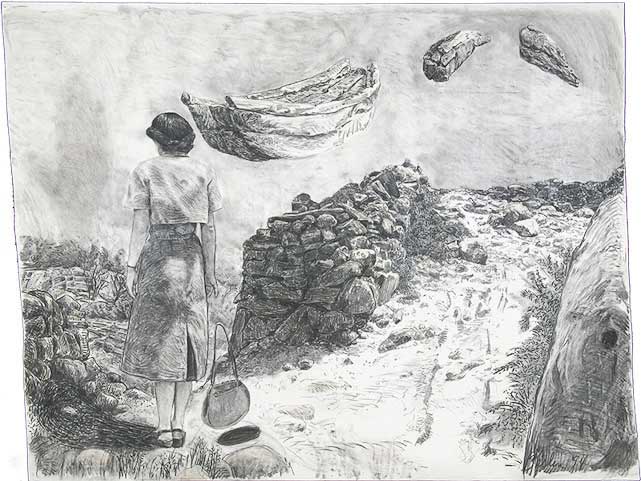
David Bailin, Salt (Lot's Wife), 1994, charcoal on paper, 96 x 144 inches
This reminds me of another similarity between
David and me in those days: we both looked back, like Lot's wife,
and we both defied gravity.
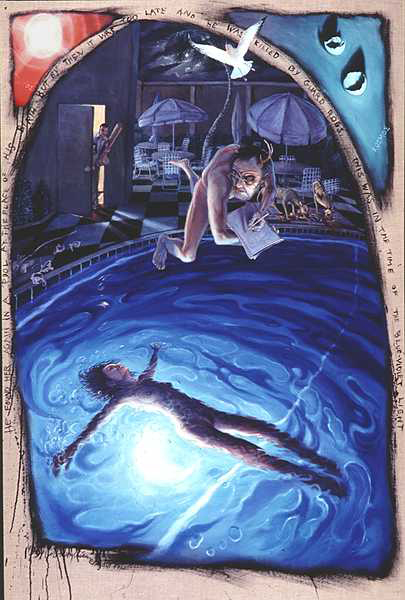
Criswell, The Pool, 1991,
oil on linen, 72 x 48 inches |
|
Because after Modernism there was no direction you had to follow.
It wasn't a dead end, it was a garden of forking paths, a liberation.
Artists were free to follow their own personal obsessions and
not be called reactionaries or dinosaurs.
Changes in styles and materials and media of course still happen
with social and cultural changes, but those are external. The
inner parts, the processes of creativity, don't change. They
are the same now as they were 35,000 years ago in Chauvet and
Altamira, and most of those parts are unconscious. Creativity
is mostly letting your unconscious override your conscious, rational
mind - the mind that tries desperately to become unique! - or
rather allowing it to give direction to your rational mind. But
creativity feeds on discovery, which means a change in perception.
So there's the problem: finding and executing changes in a changeless
process.
The true artist, the addict, like the three of us, can't keep
doing the same things over and over. We each took different paths
but we're alike in needing that fix, that hit, which is stumbling
across something new, a discovery, whether it's a sudden hypotenuse
in a painting of rectangles ...
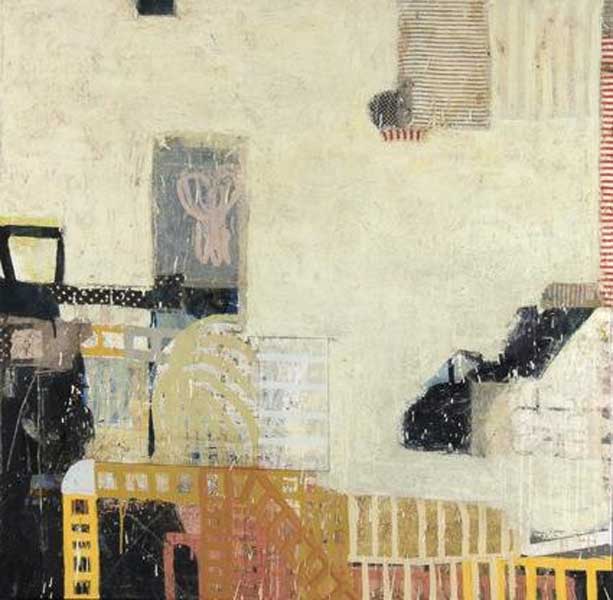
Sammy Peters, Transference: imagined; requirement,
2015, mixed media on canvas, 48 x
48 inches |
. . . or a concave curve in a model's thigh
. . .

Criswell, Psyche, 2012,
terracotta, 17 x 13 x 3 inches |
. . . or the way a stroke of paint looks over charcoal.
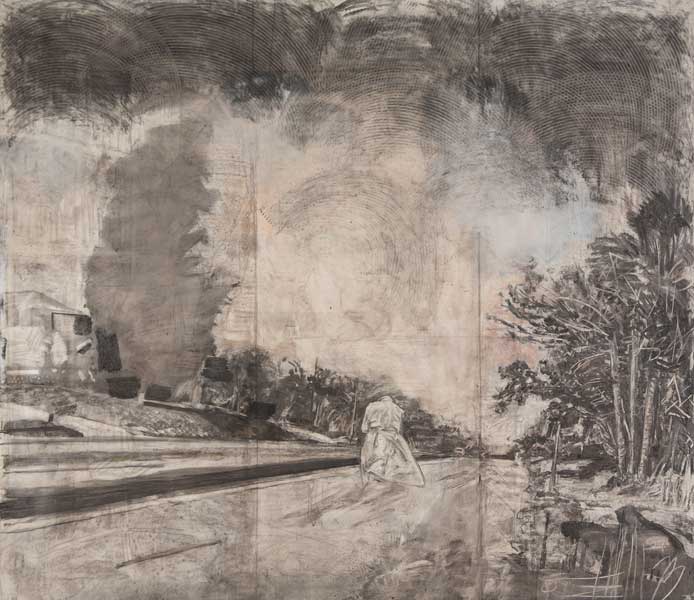
David Bailin, Raincoat, 2013,
charcoal,oil and coffee on prepared paper, 84 x 95 inches |
Yes, later we may find that we discovered that before, years
ago, but as long as we don't realize it at the time, we're good!
I remember David's despair when he thought he had exhausted Kafka
as a source . . .
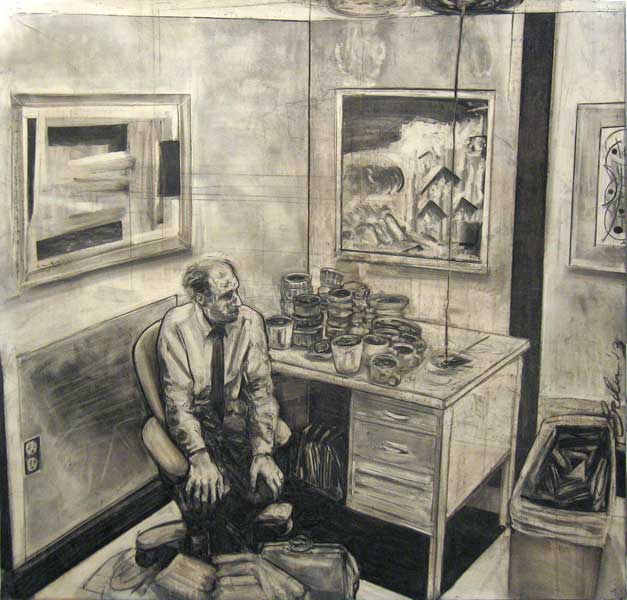
David Bailin, Drip,
2013, charcoal on prepared paper, 52 x 54 inches (Now I'm seeing
cups full of blood: bleeding but not healing!) |
. . . the same way I felt when I had brought
my Grand Inquisitor series to an end.

Criswell, All the King's Horses, 1992, oil on linen, 48 x 36 inches |
And I know Sammy is as concerned about this as David and I, because
recently when I was cleaning out my bookshelves I came across
an interview in a magazine from 2003 (Pasatiempo, Sept.
12-18, "Pleasurable Tones" by Craig Smith, p.54), where
Sammy said, "When you look back at Pollock or de Kooning
or Rothko, it looks so serial." He said he knew there was
a progression in his own work too, but "the tone and mood
from one painting to the next can jump more dramatically"
than most of the guys he used to look at.
w.jpg)
Sammy Peters, Repose: significant; memory suite, No.10,
2015, mixed media on canvas, 11 x 14 inches |
|
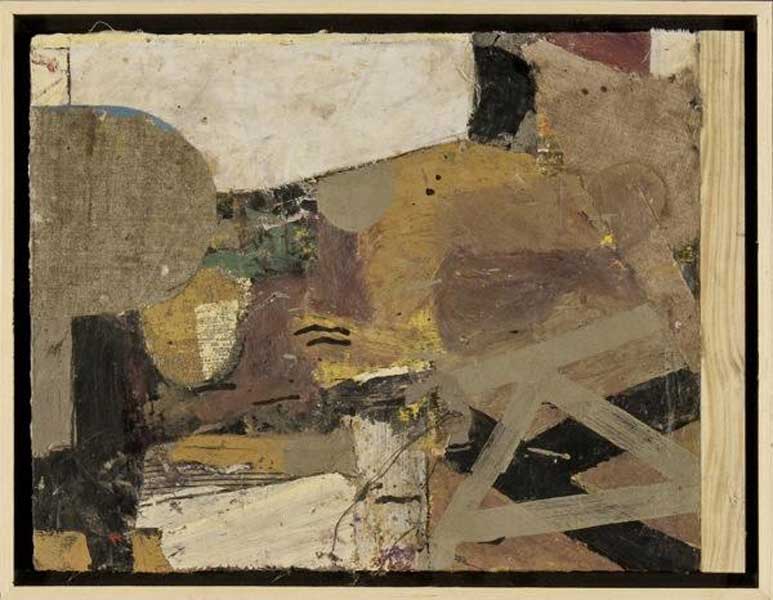
Sammy Peters, Repose: significant; memory suite, No.16,
2015, mixed media on canvas, 12 x 16 inches
|
|
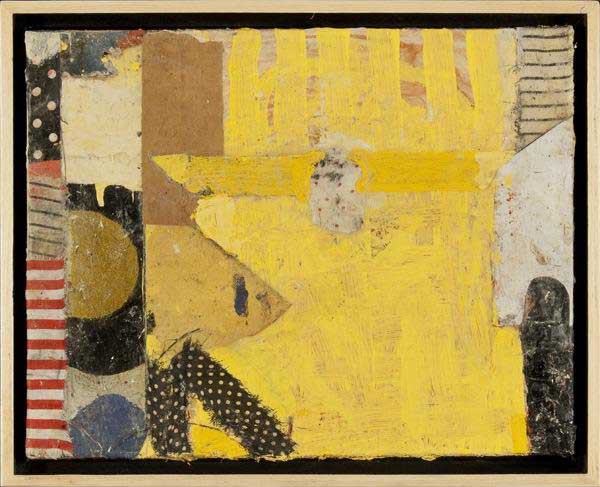
Sammy Peters, Repose: significant; memory suite, No. 9,
2015, mixed media on canvas, 11 x 14 inches
And those are all in the same suite!
|
So it's important for all of us to stay at
that edge - that doorway to the abyss that we haven't yet experienced
- or think we haven't. The trick is finding the door.
I read an article in the New Yorker about Yitang Zhang, the mathematician
who proved the "bounded gaps" problem, a 150-year-old
mystery of prime numbers, and he said exactly the same thing:
"Where is the door?" Like art, mathematics is a pursuit
of beauty, and you can't find it just because you want to or
have some formula to get there. Zhang said it was like "trying
to maneuver himself into a maze. When trying to prove a theorem,
you can almost be totally lost to knowing exactly where you want
to go." Finding your way, can happen in a moment, and "then
you live to do it again."
It's exactly the same with the artist. That's the addiction:
you live to do it again.
But that's not so easy. Art is artificial, but we want it to
be the truth. Our truth. An unsolvable conundrum. How to find
that door from artifice to truth? You can't find it because you
want to, it has to ambush you. This was Riggan's problem in the
movie Birdman, trying to get from comic book character
to serious stage artist, and he only found it by shooting himself
in the head. Benjamin Haydon and Mark Rothko found similar solutions.
Rothko didn't think people understood his work and were buying
it for the wrong reasons. (I'm not saying that's why he killed
himself, but it must have had something to do with it.) Haydon,
from Turner's time, had some success with the royalty at first
but was then ignored. Like Rodney Dangerfield, he didn't get
no respect. (Haydon shot himself but screwed that up too and
had to cut his throat.)
But those of us who are neither suicidal nor
able to cure our addiction have no choice but to keep hoping
to find those doors, going deeper into the maze. Or maybe trying
to get out. The maze, the labyrinth, keeps showing up in David's
drawings, from the early Midrash series to the recent
Dreams & Disasters.
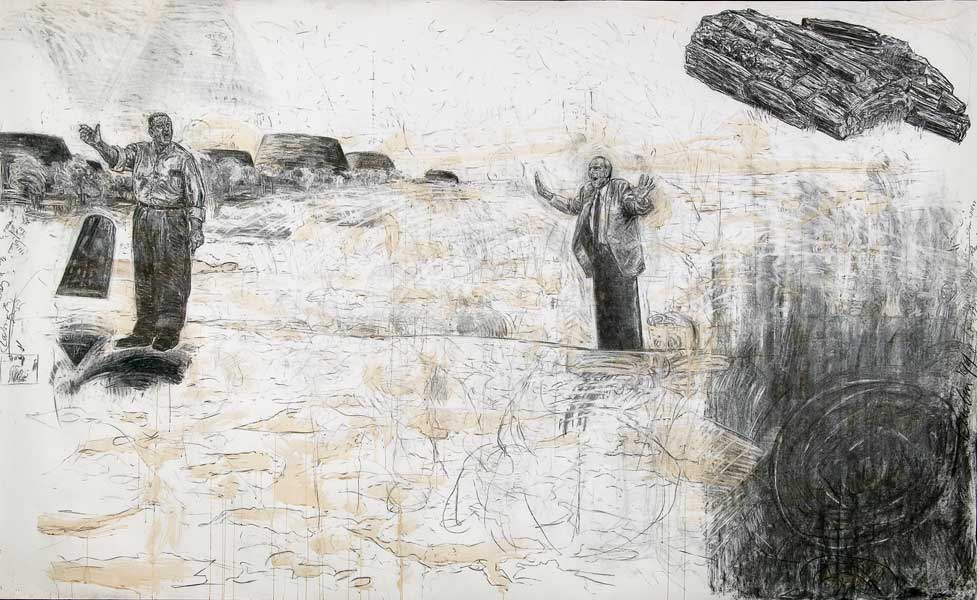 PDavid
Bailin, Pryramid (Moses and Aaron), 1999, charcoal on paper, 96 x 157 inches (Here the
labyrinth is lurking darkly in the lower right.) PDavid
Bailin, Pryramid (Moses and Aaron), 1999, charcoal on paper, 96 x 157 inches (Here the
labyrinth is lurking darkly in the lower right.) |
|
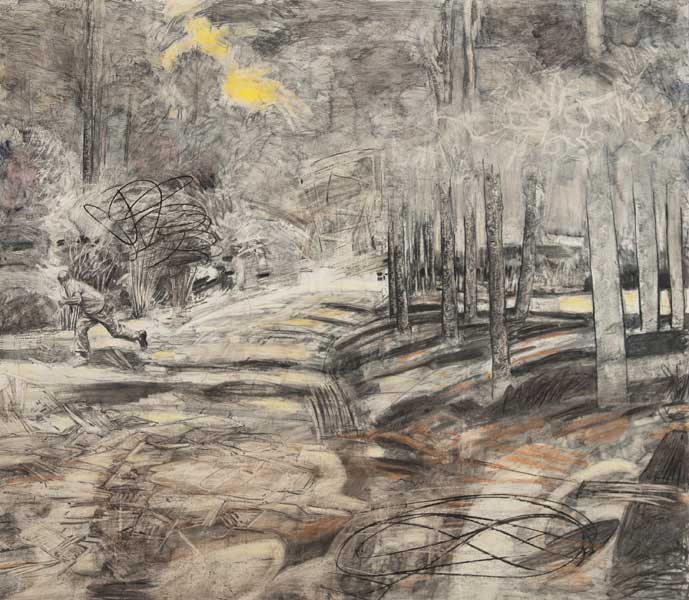
David Bailin, Papers,
2013, charcoal, pastel & coffee on prepared paper, 73 x 83
inches
(Here it whirls above the terrified bookkeeper, threatening to
swallow him up.)
|
Lately, I've been following the crumbs of my earlier work, back
out of the labyrinth, avoiding the Minotaur, making prints of
old images, hoping the Muse will take pity on me. But the Muse
has no pity. She will sing only when she's damn ready. All three
of us know the agony and terror of confronting a blank canvas
or paper, alone in our studios, and the joy when the lightning
strikes. And the fear when it doesn't.
Because the truth, the unknown entity lurking behind that door,
is not only an object of desire - it's also scary. We live our
normal lives on this side of the door, in a state of denial.
We have all the animal drives for pleasure and survival, but
we're the only animal that knows it was born and is going to
die. Art, religion and even science were born not only out of
our need to find order in chaos - to tell a story - but also
out of this terrible knowledge of our finiteness, our transience.
We ate that apple from the Tree of Knowledge and have been trying
to deal with the consequences ever since.
We hide our animal pleasures - which is why you didn't see my
videos in this
show (they were deemed a little too truthful for this
public venue) - and repress our human fears. This is necessary.
It's like when you're driving down the road, seeing only what's
necessary to get safely where you're going, editing out all the
rest. As Sherlock Holmes said, you're seeing, Watson, but not
observing. Observing can lead to dangerous things - like a wreck,
or a painting. To live our lives we have to steer a course down
the middle, avoiding the pleasures and the terrors, or else social
order would collapse. But the artist holed up in his or her studio,
in search of that monster Truth, doesn't have this luxury. We
have to try to find that door to what is either too much fun
or too scary - or, as in my case sometimes, both at once.
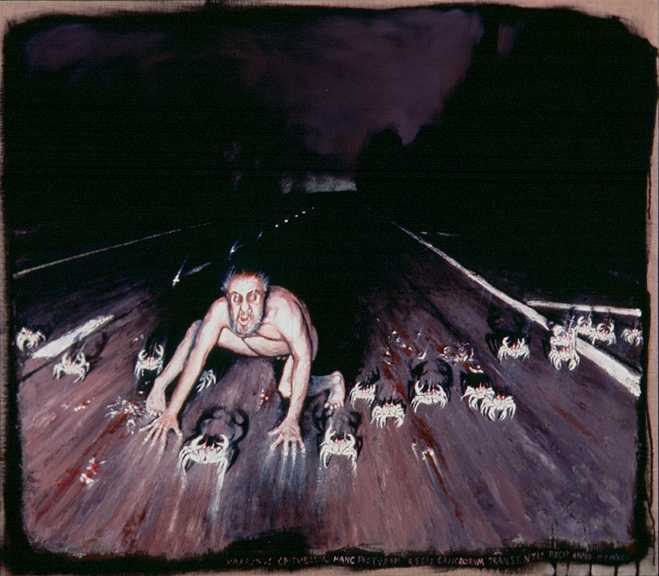
Criswell, Regis Cancorum Trahsentis (The Crab
King Crossing), 1991, oil on linen,
48 x 54 inches |
I see now that my Crab King Crossing expresses both desire
and dread! (The crabs are crossing A1A on the Florida east coast
to the beach for their annual spring orgy. A lot of them didn't
make it.) At the time I saw it as a confrontation with the Other,
and it is that too. But the Other only allows us to see ourselves
through his or her eyes. And the artist painting himself is his
own Other. Thinking also about my Dies Irae painting ...
Day of Wrath.
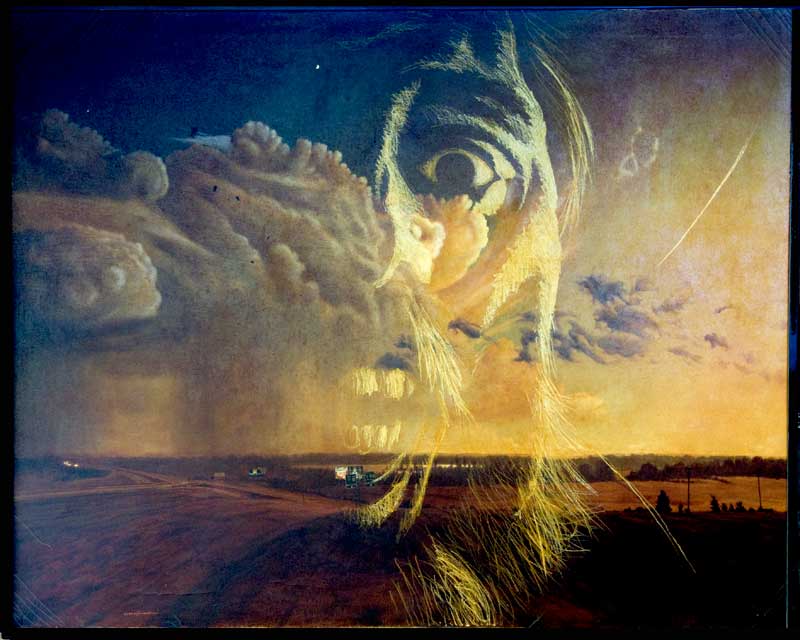
Criswell, Dies Irae,
1985, oil on canvas, 50 x 63 inches |
And I suddenly realized what the "worm" in some of
Sammy's paintings is! Many of his shapes and motifs, like David's,
have a way of reappearing and evolving in his paintings, and
one of them is this convoluted, twisted, tubular, organic looking
thing. Thinking about transference, as the psychologist call
it, is what led me to this interpretation.
Transference is kind of a tricky concept. According to Becker
and Jung, we transfer our fears and desires to an object - our
job, our family, whatever - thereby avoiding facing them directly.
But what if the object is one's art, which demands honestly confronting
both fear and desire? It looks like in that case transference
loops back on itself, feeding on itself like the Ouroboros, the
self-nourishing world snake. That's what Sammy's worm is! - to
me, that is, surely not to Sammy.
Here's one example - that black thing lurking on the right like
David's labyrinth, a python swallowing its tail.
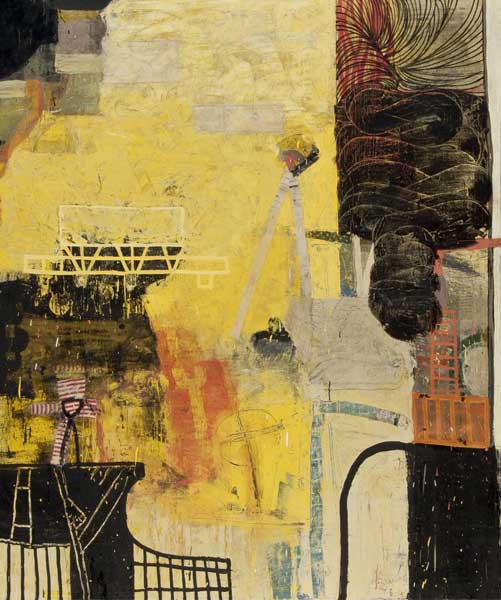
Sammy Peters, Essence: inseparable; illusion, 2015, mixed media on canvas, 72 x 60 inches
(I know this isn't the way Sammy thinks
when he's titling his paintings, but this one could be read "Essence
is inseperable from illusion." That is pure phenomenology!)
|
Becker says, "The real world is simply too terrible to admit;
it tells man that he is a small, trembling animal who will decay
and die." But for the artist that too can be an inspiration!
For the artist the truth, no matter how terrible, can open the
door to his or her creativity, and as a creator, he once more
becomes a god who has conquered his mortality - even though he
has done it by confronting the very fact of his mortality! The
Ouroboros indeed. Art with a bite.
| Otto Rank
said that the artist must "step out of the frame" of
the ruling mindset, whether one's own or the culture's, and learn
how to unlearn. Creative solutions emerge from the fluctuating,
ever-expanding and ever-contracting, space between separation
and union. Art and the creative impulse, said Rank in Art and Artist, "originate solely in the constructive
harmonization of this fundamental dualism of all life" (Ernest
Becker, The Denial of Death) |
|
Another dualism of mine has been the
urge to push forward into the undiscovered and the equally strong
urge to look backwards, like Lot's wife, into the past. I love
the cave art of our early ancestors. Already they were pushing
into the unknown, creating images of animals - mammoths, aurochs,
woolly rhinos - which they subsequently hunted to extinction.
This duality is the terrible but unavoidable truth of being human.
Neanderthals, when they came to an ocean, stopped. Humans - differing
only in a few tiny genetic variations - built boats and kept
going. Neanderthals apparently had no interest in art or discovery.
They didn't look into the past or the future. If we hadn't come
out of Africa they would probably still be around, along with
the mammoths and aurochs, hunting with the same tools they had
used for a hundred thousand years. They didn't have the "creativity
gene," as some have called it. We might also call it the
"destructivity gene." Elizabeth Kolbert, in The
Sixth Extinction, put this way:
"With the capacity to represent the world in signs and symbols
comes the capacity to change it, which, as it happens, is also
the capacity to destroy it."
Which we are doing. Even as we create and discover new things,
we're sawing off the limb we're sitting on. This can be depressing,
but for an artist it can also be perversely inspiring, and it
has shown up in my art from time to time, as in Penthesilea
. . .
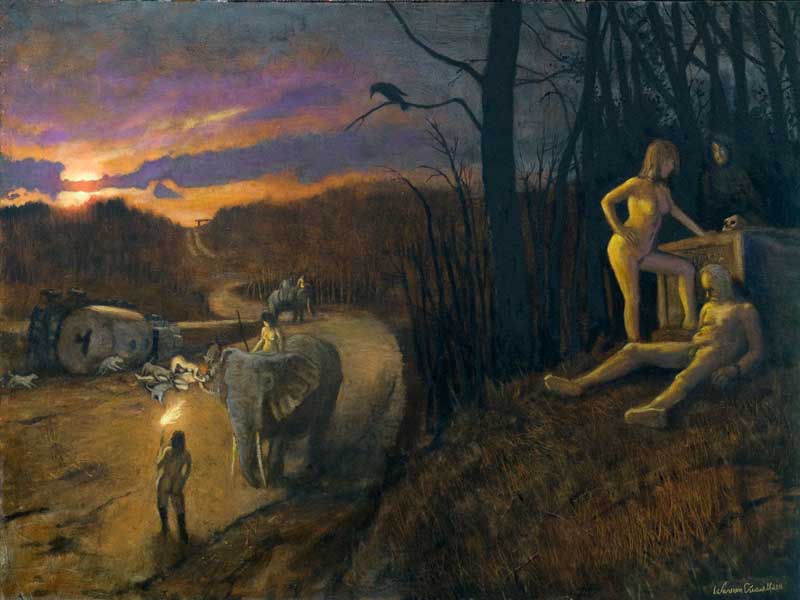
Cfriswell, Penthesilea (Love is a Dog Bite), 2011, 36 x 48 inches |
El Dorado . . .
1363w.jpg)
Criswell, Eldorado,
2013, oil on canvas, 30 x 40 inches |
. . . Two Men on Stilts, from back
in 1991, and many others.
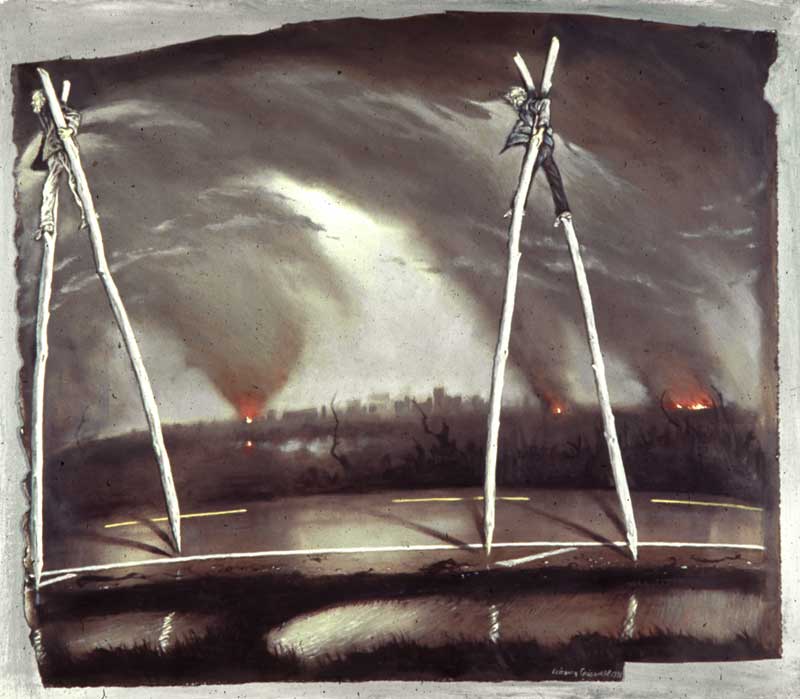
Criswell, Two Men on Stilts, 1991, acrylic & oil on paper, 46 x 53 inches |
But now I realize that while this creative/destructive dichotomy
sometimes shows up in the subject matter of my work, it's actually
an integral part of David's and Sammy's process. David is working
on a series in which he rubs out everything he draws . . .
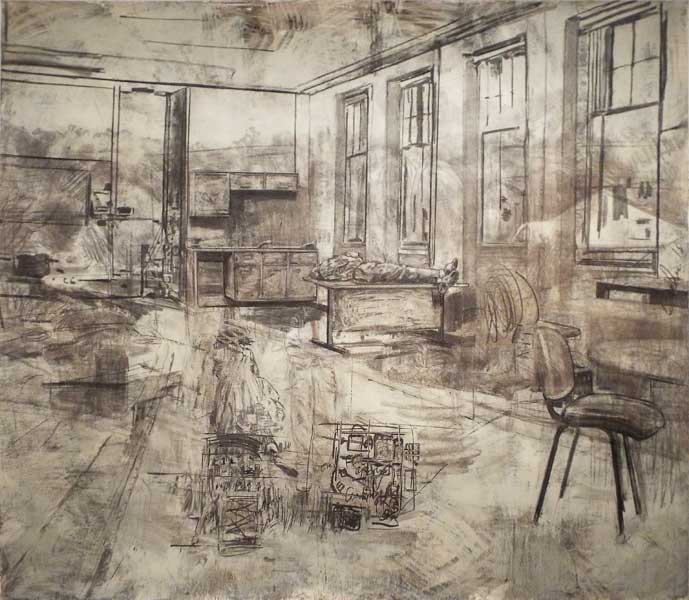
David Bailin, Red Tie,
2015, charcoal, oil, pastel & coffee on prepared paper, 72
x 84 inches |
And my favorite, a destroyed drawing from several years ago .
. .
w.jpg)
David Bailin, Destroyed drawing |
. . . in which only the ghosts are left. Even
the room is starting to fade.
And Sammy's paintings are also equal measures
of creation and destruction.
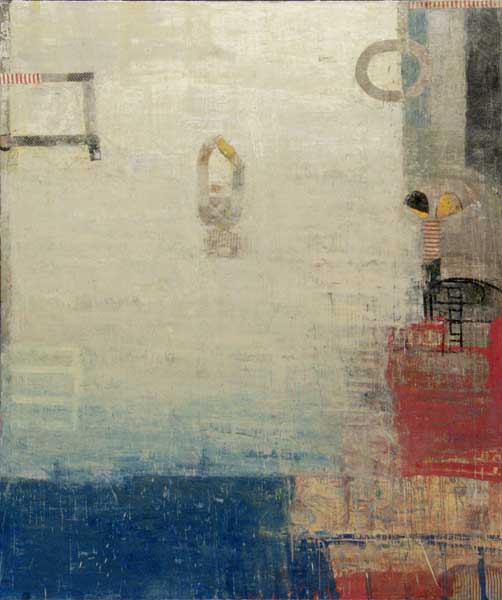
Sammy Peters, Momentary: accessible; appearance,
2015, mixed media on canvas, 72 x
60 inches |
If you look at them with an archeologist's
eye, you can imagine whole civilizations under the surface, created
and destroyed during the painting process, leaving only glimpses
of their past glory, like Ozymandias' trunkless stumps, eroding
in the desert. So in a way, their work is as scary as mine! If
I may translate another of Sammy's titles, "Appearance is
only momentarily accessible."
So even if the work we're producing in the
isolation of our studios is bleeding but not healing, as Schjeldahl
says, maybe that too can have the beauty of truth.
Warren Criswell
August 2015 |
PS. At the risk of being morbid, I can't resist
giving David the last word:
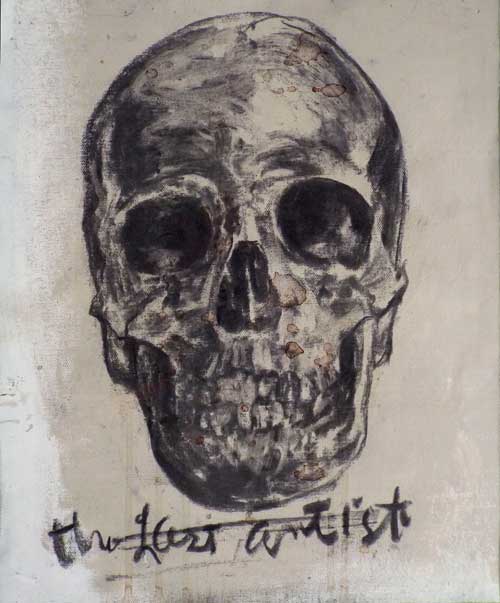
David Bailin, The Last Artist, 2015, charcoal on gessoed
canvas, 11 x 14 inches |
|
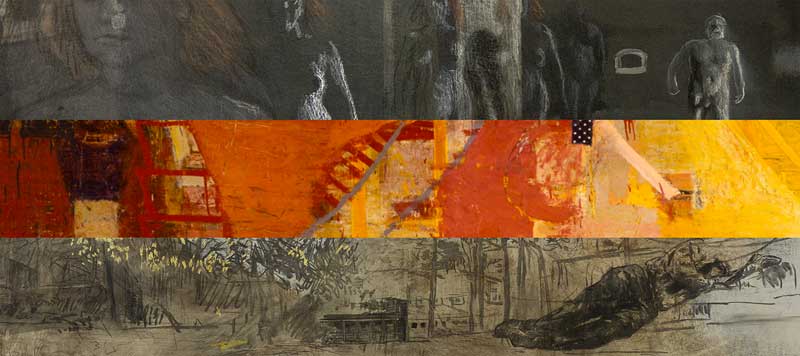








w.jpg)


 PDavid
Bailin, Pryramid (Moses and Aaron), 1999, charcoal on paper, 96 x 157 inches (Here the
labyrinth is lurking darkly in the lower right.)
PDavid
Bailin, Pryramid (Moses and Aaron), 1999, charcoal on paper, 96 x 157 inches (Here the
labyrinth is lurking darkly in the lower right.)



1363w.jpg)

w.jpg)

